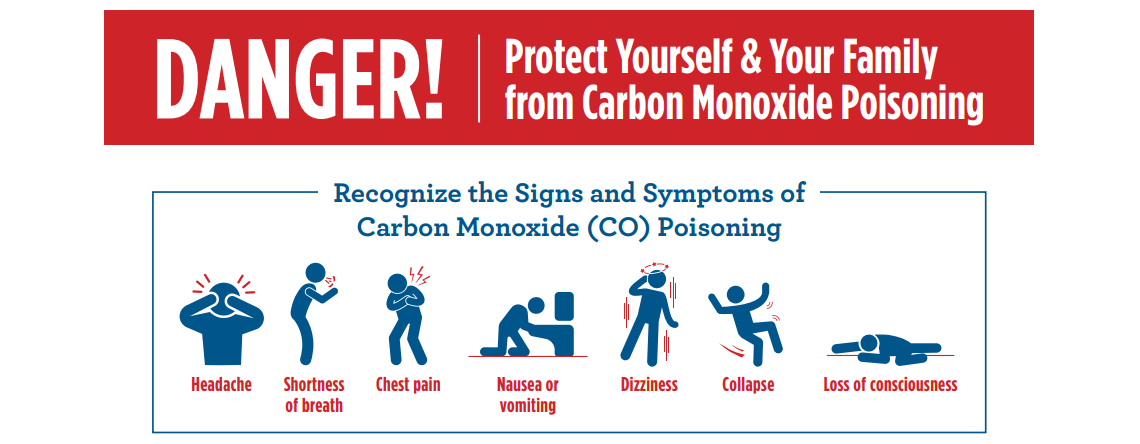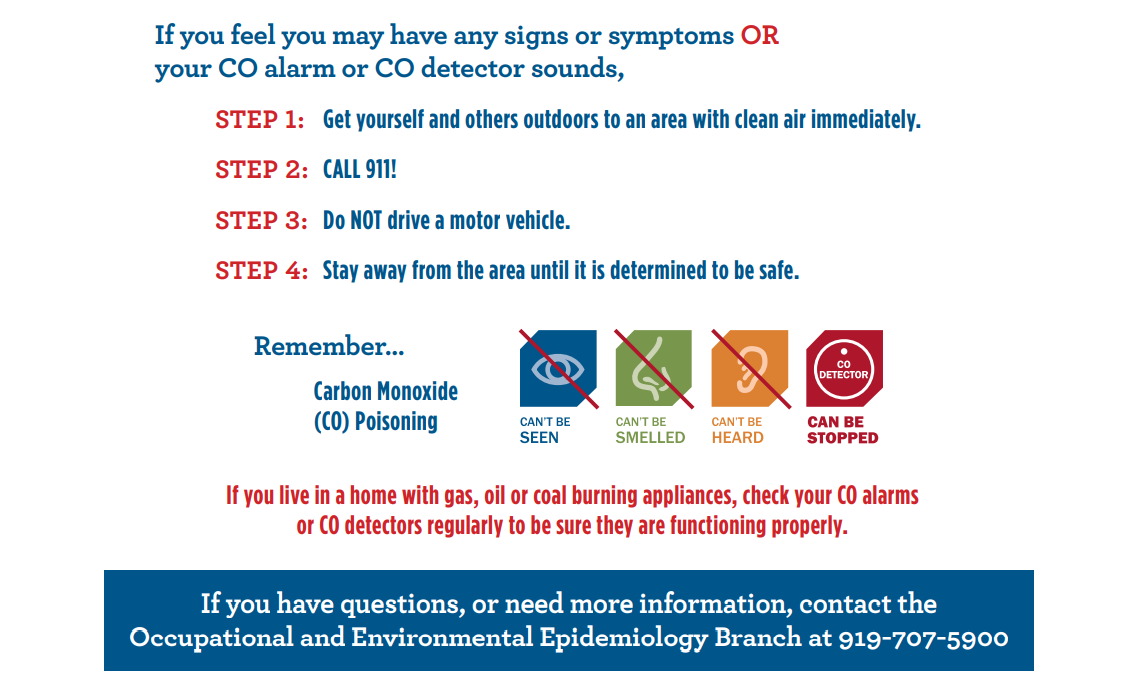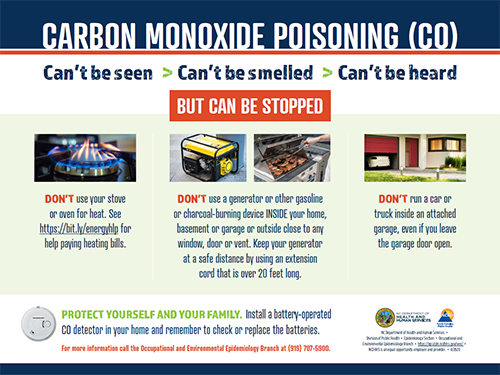Epidemiology: Occupational and Environmental
Carbon Monoxide

Carbon monoxide (CO) is a colorless, odorless, poisonous gas. Appliances, generators, heaters, and power tools fueled with natural gas, liquefied petroleum (LP gas), oil, kerosene, coal, gasoline, or wood may produce CO. Burning charcoal and running cars also produce CO.
Every year, approximately 450 people in the United States die from CO exposure and thousands visit hospital emergency rooms for treatment (Centers for Disease Control and Prevention, 2012). Cold weather or storms can be a time of increased exposures from gas-powered generators, kerosene heaters and other "fueled" heating or cooking methods. Care should be taken to ensure that only heating appliances approved for indoor use are used indoors and that rooms are adequately ventilated. Generators should be used outdoors only and placed well away from windows, doors, and vents. Boating can also pose a hazard for carbon monoxide poisoning. Some larger boats tend to have generators that vent toward the back of the boat, causing an increased danger for people swimming near the rear deck.
Everyone is at risk for CO poisoning or death from CO exposure. However, unborn babies, children, the elderly, and individuals with existing upper respiratory conditions are at greater risk for illness or death.
CDC and NCDHHS Carbon Monoxide Poisoning Prevention Poster (PDF, 433 KB)
If you are experiencing the symptoms of CO poisoning, get fresh air immediately! If you do nothing, you could lose consciousness and die.
- Open windows and doors for ventilation
- Turn off any combustible appliances
- Leave the building
- Call 911 or have someone take you to a hospital emergency room
- Tell the nurse or doctor that you suspect CO poisoning

Carbon monoxide illness and death is preventable with several easy steps:
- Install a CO detector/alarm that meets the requirements of the current UL standard 2034 or the IAS 6-96 standard.
- Make sure appliances are installed according to manufacturer's instructions.
- Never burn charcoal indoors.
- Never use portable camping equipment indoors.
- Never leave a car running in an attached garage.
- Never use gas appliances, such as a stove, to heat your home.
- Do not use gasoline-powered tools such as concrete saws or generators indoors, or outdoors near doors and windows.
- Do not operate un-vented fuel-burning appliances in rooms with closed doors and windows, or in rooms where people are sleeping.
Poster
Carbon Monoxide Poisoning Prevention Poster (PDF, 433 KB)
Infographic
Carbon Monoxide Poisoning Infographic (PDF, 599 KB)
- Arabic (PDF, 612 KB)
- Chinese (PDF, 617 KB)
- Farsi (PDF, 611 KB)
- Russian (PDF, 616 KB)
- Spanish (PDF, 592 KB)
- Vietnamese (PDF, 620 KB)
Factsheets
Carbon Monoxide Poisoning Prevention Factsheet (PDF, 477 KB)
- Arabic (PDF, 726 KB)
- Chinese (PDF, 760 KB)
- Farsi (PDF, 719 KB)
- Russian (PDF, 708 KB)
- Spanish (PDF, 681 KB)
- Vietnamese (PDF, 714 KB)
For Workplaces
- Recognize the Signs (PDF, 337KB)
- Monitoring Carbon Monoxide in the Workplace (PDF, 317KB)
- Agriculture
- Farm Safety Fact Sheet
- Public Service Announcements (PSA)
- Radio, English and Spanish
- Carbon Monoxide PSA (English) (MP3, 30 seconds)
- Transcript (PDF, 57 KB)
- Monóxido de carbono anuncio de servicio público (Español) (MP3, 56 seconds)
- Transcripción (PDF, 54 KB)
- Video
- Radio, English and Spanish
- Manufacturing
- What Employees Need to Know (PDF, 351 KB)
- What Business Owners Need to Know (PDF, 562 KB)
For First Responders
- Carbon Monoxide Safety Bulletin for Firefighters (PDF, 265 KB)
- Carbon Monoxide Safety Bulletin for EMS Personnel (PDF, 314 KB)
- A man and his dog were found dead in a trailer where a kerosene heater and gas generator were being used.
- A woman died in her apartment and another resident was treated for CO poisoning after using a charcoal grill for heat.
- Five people became ill and were transported to a local hospital emergency room after using a propane cooker in their home.
- A man died from CO poisoning when he placed a generator on his porch and fumes filled the home through a crack in the window and door. Another resident who was using oxygen for medical reasons survived.
- A family using a gas-powered generator in the garage all suffered from dizziness and fatigue.
- A woman was found dead in her living room. She had left her car running in the garage under the living room.
- Carbon Monoxide Poisonings, North Carolina, 2022 Annual Report (PDF)
- Carbon Monoxide Poisonings, North Carolina, 2017 Annual Report (PDF, 455 KB)
- Carbon Monoxide Poisonings, North Carolina, 2016 Annual Report (PDF, 214 KB)
- Carbon Monoxide Poisonings, 2016 Monthly Reports
- Carbon Monoxide Poisonings, North Carolina, December 2016 (PDF, 526 KB)
- Carbon Monoxide Poisonings, North Carolina, November 2016 (PDF, 455 KB)
- Carbon Monoxide Poisonings, North Carolina, October 2016 (PDF, 478 KB)
- Carbon Monoxide Poisonings, North Carolina, September 2016 (PDF, 526 KB)
- Carbon Monoxide Poisonings, North Carolina, August 2016 (PDF, 558 KB)
- Carbon Monoxide Poisonings, North Carolina, July 2016 (PDF, 460 KB)
- Carbon Monoxide Poisonings, North Carolina, June 2016 (PDF, 377 KB)
- Carbon Monoxide Poisonings, North Carolina, May 2016 (PDF, 454 KB)
- Carbon Monoxide Poisonings, North Carolina, April 2016 (PDF, 417 KB)
- Carbon Monoxide Poisonings, North Carolina, March 2016 (PDF, 394 KB)
- Carbon Monoxide Poisonings, North Carolina, February 2016 (PDF, 411 KB)
- Carbon Monoxide Poisonings, North Carolina, January 2016 (PDF, 418 KB)
- Carbon Monoxide Poisoning Deaths, North Carolina, 2015 (PDF, 124 KB)
- Carbon Monoxide Poisonings, North Carolina, 2015 Annual Report (PDF, 406 KB)
- Carbon Monoxide Poisonings, 2015 Monthly Reports
- Carbon Monoxide Poisonings, North Carolina, December 2015 (PDF, 305 KB)
- Carbon Monoxide Poisonings, North Carolina, November 2015 (PDF, 464 KB)
- Carbon Monoxide Poisonings, North Carolina, October 2015 (PDF, 485 KB)
- Carbon Monoxide Poisonings, North Carolina, September 2015 (PDF, 449 KB)
- Carbon Monoxide Poisonings, North Carolina, August 2015 (PDF, 441 KB)
- Carbon Monoxide Poisonings, North Carolina, July 2015 (PDF, 475 KB)
- Carbon Monoxide Poisonings, North Carolina, June 2015 (PDF, 407 KB)
- Carbon Monoxide Poisonings, North Carolina, May 2015 (PDF, 134 KB)
- Carbon Monoxide Poisonings, North Carolina, April 2015 (PDF, 116 KB)
- Carbon Monoxide Poisonings, North Carolina, March 2015 (PDF, 169 KB)
- Carbon Monoxide Poisonings, North Carolina, February 2015 (PDF, 447 KB)
- Carbon Monoxide Poisonings, North Carolina, January 2015 (PDF, 335 KB)
- Carbon Monoxide Poisoning Deaths, North Carolina, 2014 (PDF, 127 KB)
- Carbon Monoxide Poisonings, North Carolina, 2014 Annual Report (PDF, 382 KB)
- Carbon Monoxide Poisonings, 2014 Monthly Reports
- Carbon Monoxide Poisonings, North Carolina, December 2014 (PDF, 369 KB)
- Carbon Monoxide Poisonings, North Carolina, November 2014 (PDF, 301 KB)
- Carbon Monoxide Poisonings, North Carolina, October 2014 (PDF, 348 KB)
- Carbon Monoxide Poisonings, North Carolina, September 2014 (PDF, 280 KB)
- Carbon Monoxide Poisonings, North Carolina, August 2014 (PDF, 406 KB)
- Carbon Monoxide Poisonings, North Carolina, July 2014 (PDF, 331 KB)
- Carbon Monoxide Poisonings, North Carolina, June 2014 (PDF, 280 KB)
- Carbon Monoxide Poisonings, North Carolina, May 2014 (PDF, 375 KB)
- Carbon Monoxide Poisonings, North Carolina, April 2014 (PDF, 115 KB)
- Carbon Monoxide Poisonings, North Carolina, March 2014 (PDF, 373 KB)
- Carbon Monoxide Poisonings, North Carolina, February 2014 (PDF, 281 KB)
- Carbon Monoxide Poisonings, North Carolina, January 2014 (PDF, 346 KB)
- Carbon Monoxide Poisonings, 2013 Monthly Reports
- CDC: Frequently Asked Questions About Carbon Monoxide Poisoning
- CDC: Intoxicación por Monóxido de Carbono Haga Con Frecuencia Preguntas (PDF)
- CDC: Preventing Carbon Monoxide Poisoning After an Emergency
- CDC: Carbon Monoxide Hazards from Small Gasoline-Powered Engines
- CDC: Generator Safety Fact Sheet (PDF)
- CDC: Furnace Safety Fact Sheet (PDF)
- CDC: Prevent Carbon Monoxide Poisoning on Your Boat
- CDC: Carbon Monoxide Prevention Guidance
Last Modified: 10-31-2025



